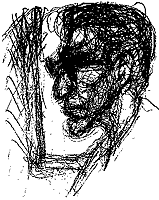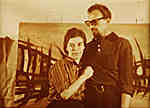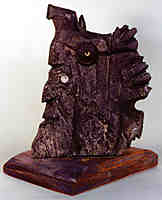|
View the Beasties of the Night A b o u t t h e A r t i s t Martin Janto, 1918 - 1993Martin Janto was born on Armistice Day in Cudahy, Wisconsin, fifth child of seven. His parents were
farmers, immigrants from what is now called Slovakia. As a youth,
he was a talented athlete and he sustained that interest throughout
his life. At the age of 14, on commission, he made a banner to
stretch across the main street of Cudahy to mark the first Infantile
Paralysis drive; a portrait of President Roosevelt. At 17, he
hitchhiked to Florida and back. He later worked for Cudahy Brothers
Meat Packing Plant, the area's largest employer. During that period,
he was active in helping to found the first meat packers' union.
|
 self portrait, 1953 |
In 1942 Martin was inducted into the army and while on active duty, sustained a serious eye injury in an accident. Martin was discharged in 1944, and began to attend the Layton School of Art in Milwaukee on the GI Bill while driving a truck at night to support his family. After graduation in 1948, he attended the Chicago Art Institute, and on proceeds from selling some art work, moved to Europe. His art at this time was generally realistic, direct, with some surreal overtones. After study at the Sorbonne in Paris, he had a successful one person show with a second one in Rome after his move there in 1952. This European period is marked with bright oranges and yellows, still figurative in subject matter, expressionistic in style.
Martin returned to the United States in 1953, and settled in New York City at a time when abstract expressionism was becoming an important and controversial movement. His early paintings in the City picked up the flavor of the environment--the buildings and bridges--while still including some figurative content. Martin now began to experiment with a drip style in very large paintings, darker in mood. Some of this work was exhibited in a one-person show at the important non-profit Artists' Gallery.
Influenced by the fervent artistic climate of the time, Martin now embarked on his major style. This entailed using an old master technique of pure glazes, thin washes of color -- sometimes as many as 60 layers, each drying before the application of the next. With this method, light hits the white ground of the canvas; the layers being translucent, clear color reflects back to the eye. In this period of Martin's oeuvre, the work is abstract, colorful and has great depth. He made many series of paintings using brilliant hues of reds, greens or blues. The colors retained clarity even when complimentaries were combined. In the second phase of this style, Martin incorporated texture onto the surface: cardboard, rice paper, burlap and Keene's cement. The paintings thus became denser and heavier. Though at this time generally abstract, Martin did a series of torsos with this added technique.
|
In 1961 Martin accepted a position as Head of the Art Department with the prestigious Browning School for Boys in Manhattan. He set up a photography darkroom, teaching photography (another interest), woodworking, ceramics and general art. He inaugurated a college level art history course, supervised maintenance and expansion of the school and was also yearbook advisor. In 1965, he and his wife Phyllis bought a home in Washington, Maine, where they summered until 1990, when they became year round residents. |
|
|
Martin's eyesight was slowly deteriorating in the 1970's. While retaining his previous methods, his paintings began to have a simpler feel, sometimes that of landscape, with large circles of gold or silver, textured with rice paper. In 1980 Martin became legally blind and no longer painted in oils; he did however still do watercolors and pastels. In 1981 Martin retired from teaching. After becoming completely blind in 1985, Martin began to make sculptures of alabaster and soapstone, pieces often having an animal, birdlike or animal-human motif. Martin called these "Beasties of the Night." His own distinctive profile, which had appeared in numerous sketches over the years, occasionally appears in the stone. Always quick and energetic, Martin might take a day or so to start and finish a work. He was always very proficient with machines of all kinds, making his own stretchers, frames and bases. He was an extremely prolific artist with a strong drive to produce. After a long illness, initially beginning in 1991, he succumbed to pneumonia June 16, 1993. |
|
Martin had three children by a first marriage, Armund, Michael and Karen. He had two children, Hrana and Paul, with his second wife Phyllis. -- Written by Phyllis Janto |
|
||
|
See the on-line show of Martin's sculptures, Beasties of the Night This site sponsored by Phyllis Janto and Hrana Janto | Site Design by Sound Visions
|


